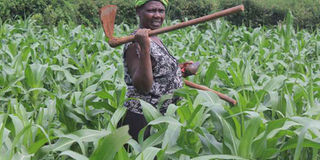Regional cooperation is a useful tool for enhancing food security among members

A maize farmer, Christine Awuor, inspects her crop in Homa Bay County. For good measure, perhaps no other agricultural crop has attracted as much research, policy recommendations, and developmental support as has maize. PHOTO | TOM OTIENO | NATION MEDIA GROUP
What you need to know:
- For good measure, perhaps no other agricultural crop has attracted as much research, policy recommendations, and developmental support as has maize.
- In many countries in the region, maize serves as both the national staple food and the primary crop grown by smallholders, thus playing a central role in the region’s strategy for promoting economic growth, reducing poverty, and improving food security.
- Approximately 13 million hectares of land are devoted to maize production annually in the Common Market for Eastern and Southern Africa (Comesa) region.
It does not matter if you call it posho, sadza, nshima, or simply ugali.
It will not matter whether you are in a café in downtown Harare or Capital Centre in Uptown Lilongwe.
The language at mealtime across the Eastern and Southern Africa region is virtually the same.
The consistency of the meal may vary from a thick porridge if you are eating at Garwe Restaurant in Harare to a hard mix if you are enjoying your fish and ugali at Ranalo on Kimathi Street in Nairobi.
What does not change is that maize and its variations form the meal of choice in this part of the world.
So much so that its availability has become synonymous with food security and in the aftermath of the Arab Spring (specifically the Tunisian “trigger” of the spring), food security has become synonymous with national security.
This explains why the commodity is such a sensitive topic even at the political table.
But perhaps it is this very politicisation that has overshadowed important debate around what should be happening to shore up production and market access for this important crop to enhance national and regional food security and incomes.
For good measure, perhaps no other agricultural crop has attracted as much research, policy recommendations, and developmental support as has maize.
Yet grain-marketing boards such as the National Cereals and Produce Board in Kenya and its cousins around the region still call the price control shots (read market distortion) some 20 years after market liberalisation.
A VALUABLE CROP
In many countries in the region, maize serves as both the national staple food and the primary crop grown by smallholders, thus playing a central role in the region’s strategy for promoting economic growth, reducing poverty, and improving food security.
Approximately 13 million hectares of land are devoted to maize production annually in the Common Market for Eastern and Southern Africa (Comesa) region.
Yet yields across the region remain low.
On average Comesa member countries achieve maize yields of only two tonnes per hectare, compared to feasible yields of five tonnes.
This low productivity contributes to a situation where overall production of maize remains well below total regional demand.
Granted, maize production in the region has risen substantially since 2000, but so have imports.
As of 2012, the region imported over 2.5 million tonnes of maize at a cost of over $500 million.
Comesa’s overall import bill on cereals stands at about over $4.5 billion with a paltry 5 per cent going to African farmers.
The impact of this amount, were it spent on intra-regional trade, would greatly impact high potential countries such as Zambia, Uganda, and Tanzania.
The spare change would go to improving infrastructure in agriculture.
While farmers in the region have struggled to produce, often in a tough policy environment, the policy makers have not done enough to provide incentives to increase production through access to better markets.
So you have a case where farmers produce and as soon as they harvest, governments impose export bans limiting their access to better markets.
ENHANCING MARKET LINKS
With farmers (80 per cent of whom are small-scale) unable to sell due to “localised glut”, they end up losing almost half of their produce due to poor post-harvest management.
Before long, they go back to buy the maize at even higher prices for their own consumption.
The next season will find them unprepared or at best waiting indefinitely for payment for their meagre deliveries from marketing boards and in the end are unable to procure certified inputs in time.
The vicious cycle goes on.
In the meantime, capital-holding private sector investors, unable to predict the next policy move by government, simply stand on the sidelines or divest from this vital regional agricultural value chain altogether.
With regional integration now unstoppable, the least governments can do is to build production capacity with guaranteed cross-border market access (Uganda is already leading the way).
The East Africa Community, Southern African Development Community (Sadc), and Comesa Tripartite Free Trade Area now under way, the regions are creating a 650 million-$1-trillion-strong market.
If, for instance, Zambian farmers can be assured of a better market at a Thika-based miller in Kenya, governments and other players should do all they can to enhance the market linkages.
The region could then be on its way to becoming truly one, one ugali meal at a time.




